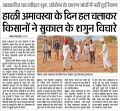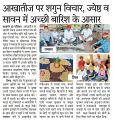Akshaya Tritiya
| Author:Laxman Burdak, IFS (R) |
Akshaya Tritiya (अक्षय तृतीया), also known as Akha Teej, is an annual Hindu spring festival.[1] It falls on the third tithi (lunar day) of the bright half (Shukla Paksha) of the month of Vaisakha. Ākhātīj (आखातीज) is the special festival of Jats celebrated on the eighteenth day of vaishakh. No muhurt is required for marriages on this day. It is believed that the attempt of Dushasan to Draupudi be shamed by being disrobed in front of the whole court was made imperishable (akshya) by Krishna. Incidentally, according to a folk song Maharaja Surajmal was born on this day.
Variants
- Akshaya Tratiya (अक्षय तृतीया)
- Akha Teej (आखा तीज)
- Akshyatritiya (अक्षयतृतीया)
- Ākhātīj (आखातीज)
Meaning
In Sanskrit, the word akṣaya (अक्षय) means "never decreasing" in the sense of "prosperity, hope, joy, success", while tr̥tīyā (तृतीया) means "third phase of the moon". It is so named since it falls on the third lunar day of the spring month of Vaisakha in the Hindu calendar, when it is observed.
Akshaya Tritiya is regionally observed as an auspicious day by Hindus in India. It signifies the "third day of unending prosperity". Akshaya Tritiya is considered auspicious by Hindus and Jains in many regions of India and Nepal for new ventures, marriages, charity, and in investments such as gold or other property. It is also a day of remembrance for the loved ones who have died. The day is regionally significant for women, married or unmarried, who pray for the well-being of the men in their lives or the one they may in future get engaged to. After prayers, they distribute germinating gram (sprouts), fresh fruits, and Indian sweets. If Akshaya Tritiya falls on a Monday (Rohini), the festival is believed to be more auspicious. Fasting, charity, and helping others on this day is another festive practice.
Hindu tradition
The festival has related the presentation of the Akshaya Patra to Draupadi by the god Krishna during the visit of numerous sages, including the sage Durvasa. During their exile in the forest, the Pandava princes were famished due to the lack of food, and their wife Draupadi was pained by this because she could not extend the customary hospitality to their guests. Yudhishthira, the eldest Pandava, prayed to the god Surya, who gave him this bowl, which would remain full till Draupadi served all of their guests. During the visit of the easily angered sage Durvasa, Krishna ate a small particle from the bowl, which deflected the wrath of the sage and saved the Pandavas from his curse. [2]
Akshaya Tritiya is believed by Hindus to be the birthday of Parasurama. He is revered in Vaishnava temples. Those who observe it in honor of Parasurama sometimes refer to the festival as Parasurama Jayanti.[3] Alternatively, some focus their reverence on Krishna. [4]
According to one legend, the sage Vyasa began reciting the Hindu epic Mahabharata to the god Ganesha on Akshaya Tritiya. Another legend states that the river Ganges descended to earth on this day.[5] The Yamunotri Temple and Gangotri Temple are opened on the auspicious occasion of Akshaya Tritiya during the Chota Char Dham pilgrimage, after closing down during the heavy snowfall-laden winters of the Himalayan regions. The temples are opened on Abhijit Muhurat of Akshaya Tritya.[6]
Another event linked to the day is Sudama's visit to his childhood friend, Krishna in Dwarka when he received unlimited wealth as a boon. Kubera is believed to have appointed the god of wealth on this auspicious day.[7]
This day is auspicious for those who buy rice, deposit money in a bank account, buy any kind of new things or vessels - visiting temples, donating foods or special offers for poor people, or helping poor children for their education fees, all are good signs for Akshaya Tritiya. [8]
किसानों का महापर्व आखातीज
इस बार वैशाख सुदी तीज दो होने से आखातीज पर्व चार दिन मनाया जा रहा है. इसे अकाल-सुकाल को लेकर सबसे महत्वपूर्ण पर्व माना जाता है. इन चारों दिन आंगन में सात अनाजों बाजरा, गेहूँ, मूंग, मोठ, तिल, ग्वार और मतीरा के बीजों के अलग-अलग ढेर किये जाते हैं. साथ ही गुड़ की डली और पानी से भरा लोटा कच्चे सूत /रोली से लपेट कर रखे जाते हैं. यदि अनाज पर पहली चोंच चिड़िया भरे तो सुकाल माना जाता है और पहली चोंच कौआ भरे तो अकाल माना जाता है. इस दिन कौए का बोलना भी अशुभ माना जाता है.
किसान सुबह अंधेरे खेत में जाकर शगुन देखते हैं. खेत में पशु पक्षियों शगुनचिड़ी, हिरण, धोडा, धोलाढींग, बुड़िया की बोली से शगुन विचारे जाते हैं. अब धोडा, धोलाढींग तो प्राय: लुप्त होते जा रहे हैं. छोटे बच्चों द्वारा किसानों की परम्परागत वेशभूषा में किसान बनकर अलसुबह लकङी के हल जोते जाते हैं और सात तरह के अनाज बोए जाते है. बालक झुण्ड में टोकरियाँ बजाकर खुशी मनाते हैं. यह किसानों को खरीफ फसल की तैयारी करने का जागृति संदेश होता है.
अमावस्या व दूज के दिन बाजरा का खींच बनाया जाता है. तीज के दिन गुड़राब व गेहूँ की चपाती बनती हैं. युवा, बुजुर्ग घर घर जाकर बाजरे का खींच एवं सांगरी की सब्जी जीमते हैं और शगुन विचारते हैं. हाळियों (बालकों) के हल जोतने के बाद घर आने पर ग्रामीणों द्वारा घर-घर एवं गुडाळों में तिलक लगा, मोळी बांध, गुङ खिलाकर मुंह मीठा करवाया जाता है.
आखातीज के दिन किसानों द्वारा कच्ची मिट्टी के चार बर्तन बनाए जाते हैं, उनमें पानी भरा जाता है. चारों बर्तनों को चौमासे के चारों महीनों ज्येष्ठ, आसाढ, सावण, भाद्रपद, आसोज नाम दिया जाता है. जो बर्तन सबसे पहले फूटता है, उसके बारे में माना जाता है कि उस महीने में अच्छी बरसात होगी. यदि कोई बर्तन नहीं फूटता है तो भविष्यवाणी की जाती हैं कि उस महीने में बारीश नहीं होगी.
इसी प्रकार आखातीज के दिन सफेद और काली ऊन की दो पूणिया एक ही बड़ी पानी से भरी परात या तगारी में रखी जाती हैं. सफेद को सुकाल और काली को अकाल का प्रतीक माना जाता है. यदि सफेद पहले डूब जाती हैं तो माना जाता है कि अकाल होगा और काली पहले डूब जाती है तो खुशी का अनुभव होता है कि अकाल डूब गया और सुकाल आएगा |
सुद पड़वा वैशाख री, भरणी नखतर होय | जाणीजै तिण थंभ रो, घास घणौ निपजाय ||
सुद वैशाख प्रथम दिन, बादल वीज करै | दामां बिना विसायजै, पूरी साख भरै ||
पड़वा दूज वैशाख री, होय उजालो पाख | बादल थिर रै जाय तो, आछी निपजै साख ||
अक्खा रोहण बाहरी, राखी श्रवण न होय | पो ही मूल न होय तो, मही डूलंती जोय ||
आखातीज के दिनां ,गुरू रोहिणी संजोत | सहदेव जोशी कहत हैं, विपदा माल बहोत ||
आखातीज पीठ दे, वावळ आवै मोड़ी | जो जलदी दिन पांच सात, तो साख निपजै थोड़ी ||
आखातीज मास एक दे, वावळ आवै काळी | भर भादरवै गाजसी, मेघ घटा मतवाळी ||
ये कहावते सार्वभौमिक है, सत्य के निकट हैं, अविचल है, अडिग है और आने वाली पीढी के लिए अकाल -सुकाल ,बरसात के लिये मार्गदर्शक है |
लेखक - भेराराम आर भाखर, शिक्षक एवं पर्यावरण प्रेमी
References
- ↑ Akshaya Tritiya 2017: Here is Why it is of significance in Hinduism and the reason behind people buying Gold on this day!". NewsGram. 28 April 2017.
- ↑ [1]
- ↑ J. Gordon Melton (2011). Religious Celebrations: An Encyclopedia of Holidays, Festivals, Solemn Observances, and Spiritual Commemorations. ABC-CLIO. pp. 18–20. ISBN 978-1-59884-206-7.
- ↑ K V Singh (2015). Hindu Rites and Rituals: Origins and Meanings. Penguin. pp. 39–40. ISBN 978-93-85890-04-8.
- ↑ J. Gordon Melton (2011). Religious Celebrations: An Encyclopedia of Holidays, Festivals, Solemn Observances, and Spiritual Commemorations. ABC-CLIO. pp. 18–20. ISBN 978-1-59884-206-7.
- ↑ Gangotri and Yamunotri temples open on Akshay Tritiya
- ↑ "Akshay Tritiya". Ganesha Speaks. 4 January 2017.
- ↑ "Akshaya Tritiya story and history". wellstuff. 29 April 2022.














